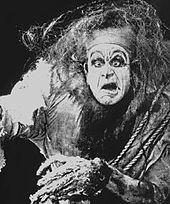Edison Studios
Thomas A. Edison | ||
| Defunct | 1918 | |
|---|---|---|
| Headquarters | United States | |
Number of locations |
| |
Area served | United States, Europe | |
Key people |
| |
| Products | Parent Edison Manufacturing Company (1894–1911) | Thomas A. Edison, Inc. (1911–1918) |
Edison Studios was an American
All of the company's films have fallen into the public domain because they were released before 1928.History

The first production facility was Edison's Black Maria studio, in West Orange, New Jersey, built in the winter of 1892–93. The second facility, a glass-enclosed rooftop studio built at 41 East 21st Street in Manhattan's entertainment district, opened in 1901. In 1907, Edison had new facilities built, on Decatur Avenue and Oliver Place, in the Bedford Park neighborhood of the Bronx.

Thomas Edison himself played no direct part in the making of his studios' films, beyond being the owner and appointing
The first commercially exhibited motion pictures in the United States were from Edison, and premiered at a Kinetoscope parlor in New York City on April 14, 1894. The program consisted of ten short films, each less than a minute long, of athletes, dancers, and other performers. After competitors began exhibiting films on screens, Edison introduced its own, Projecting Kinetoscope, in late 1896.
The earliest productions were brief "actualities", showing everything, from acrobats, to parades, to fire calls. But, competition from French and British story films, in the early 1900s, rapidly changed the market. By 1904, 85% of Edison's sales were from story films.
In December 1908, Edison led the formation of the
The breakup of the Trust by federal courts, under
Notable productions

Some of the studio's notable productions include
Legacy
Everson, calling Edison Studios "financially successful and artistically unambitious," wrote that other than directors
However, new restorations and screenings of Edison films in recent years contradict Everson's statement; indeed, Everson citing The Land Beyond the Sunset points out creativity at Edison beyond Porter and Collins, as it was directed by Harold M. Shaw (1877–1926), who later went on to a successful career directing in England, South Africa, and Lithuania before returning to the US in 1922. Other important directors who started at Edison included Oscar Apfel, Charles Brabin, Alan Crosland, J. Searle Dawley, and Edward H. Griffith.
Notable films
-
Blacksmith Scene (1893)
-
Fred Ott's Sneeze (1894)
-
Annie Oakley shooting glass balls, 1894
-
Leonard-Cushing fight (1894), the first boxing match on film.
-
The Kiss (1896), the first love scene on film.
-
What Happened on Twenty-third Street in New York Cty (1901)
-
The Great Train Robbery (1903), the first "Western" ever filmed.
-
The Messenger Boys Mistake (1903)
-
Nervy Nat Kisses the Bride (1904)
-
Battle of Chemulpo Bay (1904), a re-enactment of the Battle of Chemulpo Bay.
-
The Night Before Christmas (1905), an early film adaptation of the 1823 poem, "A Visit from St. Nicholas".
-
The climax of Frankenstein (1910), the first film adaptation of the 1818 novel Frankenstein.
See also
- it:Filmografia della Edison Edison Studios Filmography[7]
References
- ISBN 9780306802614.
- ^ "Motion Picture Patents Company". Encyclopædia Britannica. Encyclopædia Britannica Online. Retrieved 2007-04-13.
- ^ U.S. v. Motion Picture Patents Company., 225 F. 800 (E.D. Pa. Oct. 1, 1915).
- ^ "Company Records Series – Motion Picture Patents Company". The Thomas A. Edison Papers. Retrieved 2007-04-13.
- ^ Eagan, Daniel (2011). "Five Films About Faith", Smithsonian Magazine (Washington, D.C.), 15 December 2011, online copy of article from the Smithsonian Institution's original printed periodical. Retrieved 8 August 2021.
- ISBN 0-306-80876-5.
- ^ https://dokumen.tips/download/link/the-studios-edison-edisons-assistant-william-kennedy-dickson-who-supervised-the.html
External links
- List of Edison Company films (1891-1898) is available for free viewing and download at the Internet Archive
- List of Edison Company films (1899-1902) is available for free viewing and download at the Internet Archive
- List of Edison Company films (1902-1922) is available for free viewing and download at the Internet Archive
- EdisonStudios.net (includes a viewable Edison Studios 1910 adaptation of "Frankenstein")
- Vernon K. Flaherty and R. Brian Flaherty collection (R9144) at Library and Archives Canada. The collection consists of twenty documentary and fiction films by Thomas Edison.
